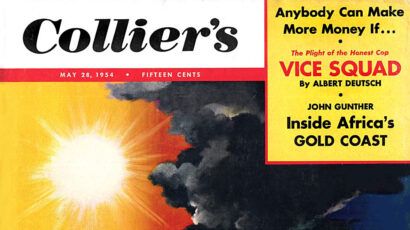A bright shining life
By Cameron Reed | August 28, 2013
Robert Oppenheimer: A Life Inside the Center
Ray Monk
825 pages, $37.95
Any biographer who takes on Robert Oppenheimer, so-called father of the atomic bomb, faces a challenging task and no small amount of well-established competition. The field of Oppenheimer literature is populated with treatments that range from relatively brief memoirs to Kai Bird and Martin Sherwin’s American Prometheus, the first truly full-scale biography. But the richness of the “Oppie” saga will keep historians, philosophers, political scientists, and sociologists occupied for years. A brilliant theoretical physicist, Oppenheimer was tapped in 1943 to direct the US government’s highly secret bomb design laboratory at Los Alamos. After World War II he became the public face of the early atomic age, only to later face accusations of unpatriotic behavior.
Ray Monk, a professor of philosophy at the University of Southampton, has produced a worthy competitor to Bird and Sherwin’s work. Robert Oppenheimer: A Life Inside the Center (first published in Britain as Inside the Center: The Life of J. Robert Oppenheimer). Monk relates that he was motivated to begin his book just before American Prometheus was published because he felt that no “full and complete” biography of Oppenheimer existed. He still feels that way, arguing that Bird and Sherwin did not produce such a work because “they either ignore altogether or summarize very briefly [Oppenheimer’s] contributions to physics.” Readers familiar with Bird and Sherwin will know that this is simply not true; the real purpose of this assertion is to serve as a launching point for Monk’s organizing metaphor, which is built around Oppenheimer’s research on mesons.
Mesons were introduced into theoretical physics as particles that mediate forces between protons and neutrons in the nuclei, or very center, of atoms. Monk uses them to represent what he asserts is the essence of Oppenheimer’s personality: a desire to be at the center of the action, especially when it came to the physics of his day. This imagery runs throughout the book, and while it is an ingenious literary device, it eventually suffers from overuse; Oppenheimer’s life story is sufficiently compelling to stand on its own merits.
Monk mostly follows Oppenheimer’s life chronologically. He opens with an extensive survey of his family’s background and its very successful assimilation in America, after which the narrative moves through Oppenheimer’s life in a succession of “centers”: Harvard University; Britain’s Cambridge, where he worked in experimental physics and was deeply unhappy; Germany’s Göttingen, where he worked in theoretical physics and bloomed; California, where he established equally outstanding centers of theoretical physics at Berkeley and Caltech; Los Alamos, where he was director; and on to pivotal positions in virtually every postwar American nuclear-weapons policy group until the revocation of his clearance following his brutally-choreographed 1954 security hearing. The final chapters take the reader through Oppenheimer’s directorship of the Institute for Advanced Study—again at the center of something—and his prominence as a public speaker and scientific pundit.
Monk provides a thorough and very readable guide to Oppenheimer’s life. However, some elements of his style detract from an otherwise enjoyable experience. He has a tendency to delve into analyses of events that are for the most part self-explanatory, and while his intent is sincere, the effect can be condescending, as if he fears that readers will not be clever enough to figure things out. Conversely, there are instances where he makes a statement about something or someone, but leaves readers wondering how it relates to the larger story.
On occasion Monk attempts new interpretations of well-examined events in the Oppenheimer chronicle, but these are stretches at best. The most egregious example is speculation that in choosing the name Trinity for the July 1945 test of what was known as the “gadget” (and a month later would be known as the Fat Man plutonium bomb), Oppenheimer was not motivated by the poetry of John Donne—as he suggested to General Leslie Groves—but by memories of exploring New Mexico in the summer of 1922 as a member of a “troika” with his classmate Francis Fergusson and the writer Paul Horgan.
Monk should be lauded for his clear descriptions of much of the science involved. His explanations of phenomena such as the uncertainty principle and the concepts of critical mass and implosion are excellent. However, he also makes misleading statements and outright factual errors of varying degrees of seriousness. A partial list includes: attributing Francis Perrin’s estimate of the critical mass of uranium to Rudolf Peierls; incorrectly describing the Oak Ridge X-10 nuclear reactor as a prototype for the Hanford reactors; describing the explosive charges in the Fat Man bomb as being arranged in a circular configuration as opposed to a spherical one; and repeated use of the term “fissionable” when “fissile” would be more technically correct. These are not fatal flaws in a biographical work, but their number and breadth are surprising given how thoroughly these topics are discussed in literature the author cites.
In 1954, as a consequence of Oppenheimer’s objections to the development of the hydrogen bomb—a type of nuclear weapon with great explosive power—as well as suspicions that he may have been a communist sympathizer or even a spy, the US Atomic Energy Commission subjected him to a security hearing to determine whether he should continue to be allowed to act as a government consultant. He was declared a security risk and stripped of his clearance. Monk acutely highlights the great irony of this tragedy: that Oppenheimer was in fact fiercely patriotic. In advocating for the development of tactical fission weapons as opposed to the “super” fusion bomb that had no credible military mission, Oppenheimer had a much more sensible view of the world situation, and of how to best use American talent and resources, than did his detractors. He was assuredly guilty of the arrogance and sense of imperviousness that often accompany brilliance, wealth, success, public exposure and strongly-held opinions, but there is not a shred of evidence that he ever acted to the detriment of his country.
Serious students of Oppenheimer will likely not find anything strikingly new in Monk’s book, but this volume is a serious contribution to the genre and should find a place in their collections: He has risen to the challenge of doing his subject justice. As physicist and Nobel laureate Isidor Rabi put it, Oppenheimer was “a man who was put together of many bright shining splinters.” The various biographies of Oppenheimer all capture reflections of different ones.
Together, we make the world safer.
The Bulletin elevates expert voices above the noise. But as an independent nonprofit organization, our operations depend on the support of readers like you. Help us continue to deliver quality journalism that holds leaders accountable. Your support of our work at any level is important. In return, we promise our coverage will be understandable, influential, vigilant, solution-oriented, and fair-minded. Together we can make a difference.
Topics: Book Review, Nuclear Weapons















